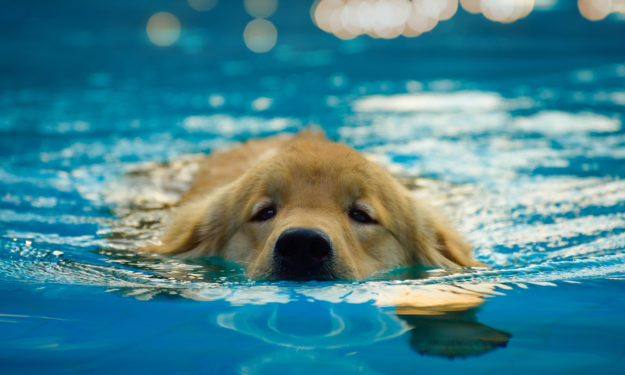Water Safety and Your Pet

Written by Meghan Glazer, DVM
As the summer approaches, we all know this brings with it time on the water – be it the lake, river or backyard pool. While enjoying the outdoor atmosphere, it is important to consider your pet’s safety around water.
First Things First…Can your Pet Swim?
If not, naturally a close eye on your pet’s movements around water is indicated. If unsure, assisted swims can be a helpful way to determine your pet’s comfort level in the water. Just as with any child, it is an excellent idea to place a pet friendly life vest on your dog or cat to ensure an extra safety measure in place.
What Happens if my Pet goes Underwater?
Unless you have an experienced diver on your hands, there is certainly a concern for any pet that has their head go under water. The primary concern lies with aspiration of water, which can lead to aspiration pneumonia. If your pet is under water long enough, this can even place a pet at risk of drowning.
If you have concern that your pet has gone under water unintentionally (however brief or long period of time), it is recommended to immediately get them out of the water for a break to breathe. If you note a lot of coughing or water being produced from their mouth/nose, it is recommended to have an evaluation by a veterinarian to assess for potential aspiration of water.
If you have concerns that your pet has gone underwater for an extended period of time, and is subsequently not breathing well, you can gently pat on the side of their chest to aid with coughing and expelling water from the lungs. If your pet is not breathing due to an extended period under water, you may place your dog/cat on their side, cover the mouth/nose and administer rescue breaths every 10 seconds while getting them to an emergency veterinarian.
What Happens if my Dog Ingests Lake or Pool Water?
There are several conditions to consider with a pet drinking from any outdoor water source.
We can see gastro-intestinal upset from some pool chemicals or stagnant (possibly contaminated) water. While these are often not classified as ‘toxicities,’ certain water sources can have chemicals or bacteria that cause vomiting, diarrhea, or poor appetite in your pet. These symptoms are predominantly self-limiting and do not often require treatment, but if symptoms persist, evaluation by your veterinarian is recommended.
There can also be concerns in some warmer, shallower lakes for cyanobacteria (blue green algae). Unfortunately, this can be a severe toxicity for dogs when ingested. Symptoms can vary from acute and severe vomiting, diarrhea, respiratory difficulties, tremors, lethargy, weakness or collapse. If these signs are noted in your pet, immediate presentation to an emergency veterinarian is recommended.
You can potentially avoid these symptoms or toxicities with a few tactics:
- Discourage your pet from drinking the water (easier said than done!)
- Avoid visiting pools that have been recently treated with chemicals or lakes that appear to have a film of algae on the surface
- Rinse your pet off after swimming to ensure they do not ingest any potential toxins from licking their fur post swim
Overall, we recommend close monitoring of your pet’s behavior and comfort around water sources. Just a few simple preventative measures can help ensure you and your furry friend both have a great summer on the water!